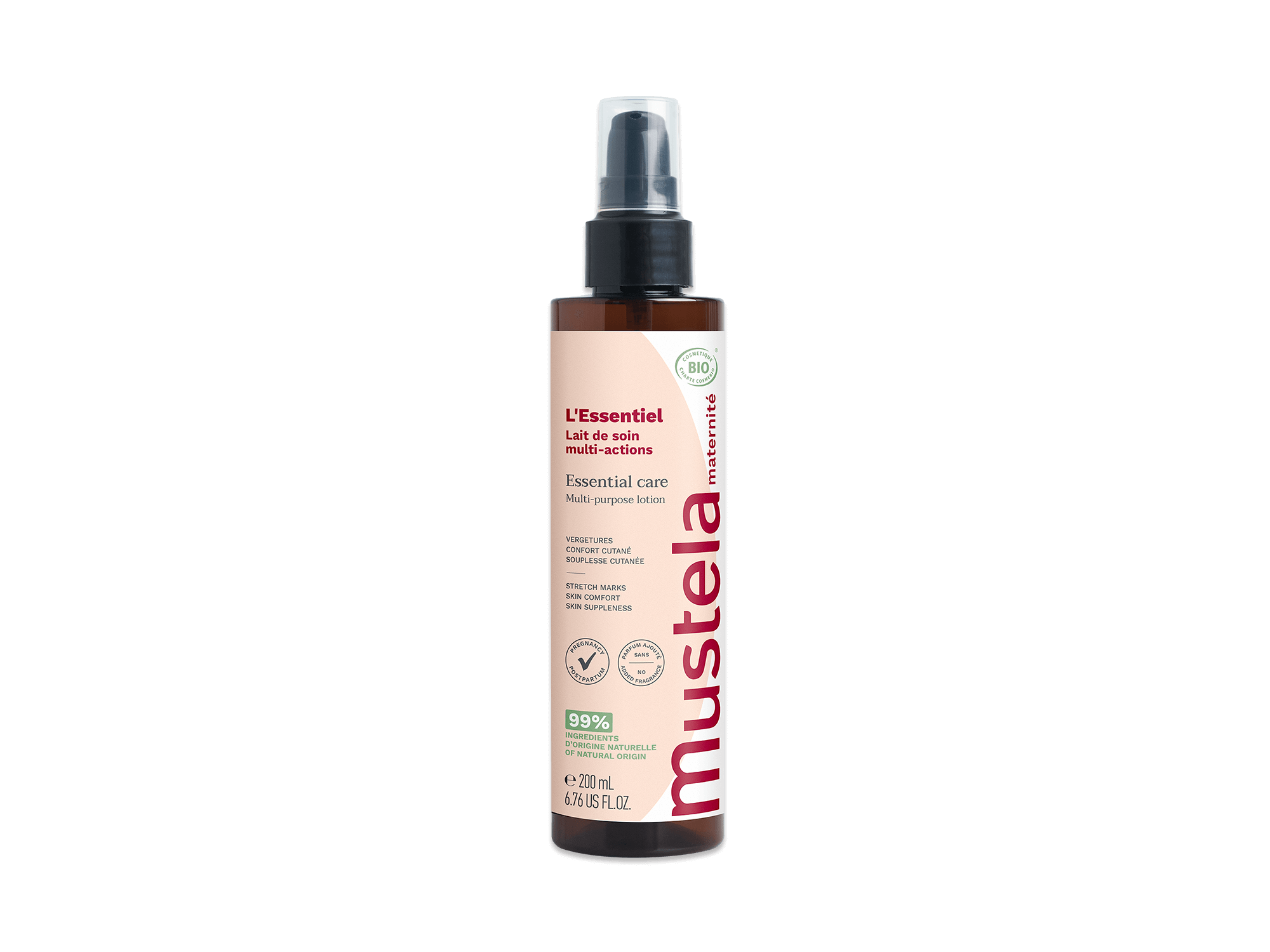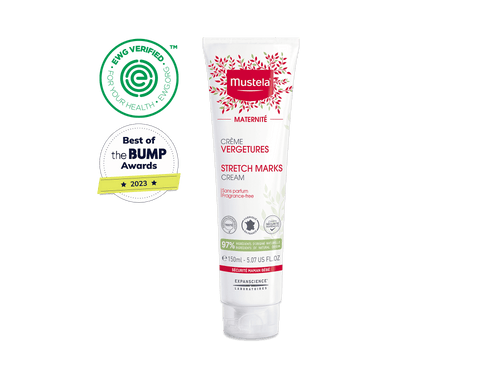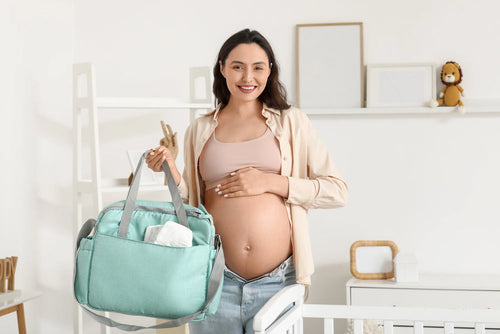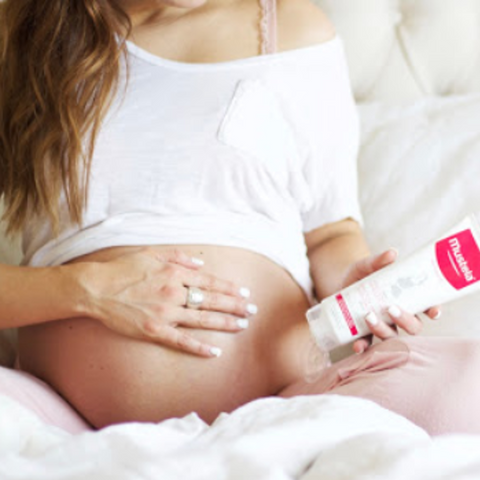Pregnancy brings all sorts of new (but expected) changes to your body — like a rapidly growing belly, backaches, morning sickness, and stretch marks. What you might not expect is a pregnancy rash on your belly, also known as PUPPP or PEP.
PUPPP can be concerning at first, but there’s no need to worry. If you’re wondering if you have this pregnancy rash, stick around. In this article, the experts at Mustela will tell you what it is, what the symptoms are, and how to treat it naturally.
Table Of Contents
- What Is Pregnancy Rash (PUPPP)?
- Symptoms of PUPPP
- How To Treat PUPPP
- Tips For Taking Care Of Yourself
- Control The PUPPP Rash Itch And Wait For Baby
What Is Pregnancy Rash (PUPPP)?
This pregnancy rash goes by a couple of different names: pruritic urticarial papules and plaques of pregnancy (PUPPP) and polymorphic eruption of pregnancy (PEP). To keep things simple, in this article, we’ll simply refer to it as PUPPP.
What causes it? While PUPPP is relatively common, it’s not entirely understood. Some think it’s an immune response to fetal antigens or an inflammatory response to tissue damage that can occur from your growing baby belly.
Others believe it could also have something to do with all of the pregnancy hormones in your body. 
All to say, doctors aren’t completely sure why PUPPP crops up. But they do know that PUPPP more commonly happens to women who are pregnant for the first time or are pregnant with more than one baby.
Unusually enough, the rash strikes moms carrying baby boys more often than moms carrying baby girls. It usually shows up in the third trimester and goes away a week or two after giving birth.
Even though we can’t know exactly why some women suffer from this irritating rash, let’s talk about what PUPPP looks like and how to know if you’ve got it.
Symptoms of PUPPP
As if your stretch marks weren’t already enough of a bother, this pregnancy rash begins in those pesky lines. You’ll first notice tiny, itchy, pink or red bumps in your stretch marks.
In a few days, the rash might form larger red skin plaques that cover more of your body — spreading from your belly to your legs, bottom, arms, and hands but usually not past your chest. If you have fair skin, you may also notice a lighter ring around the rash.
Most of all, you won’t be able to ignore the rash because it’s also incredibly itchy.

That said, if you have a red, itchy rash, it may not be PUPPP. You could also have a different, more concerning skin condition known as pemphigoid gestationis (PG). It’s important to see your doctor to determine the cause of your rash.
You might have read this far and realized that you don’t have PUPPP; you just have bothersome, itchy stretch marks. If that’s you, Mustela can help!
Caring For Itchy Skin And Stretch Marks
Apply our Stretch Marks Serum (both now and after your little one comes!) to moisturize and help minimize the appearance of recently formed stretch marks.

A concentrated hydrating serum designed for use during pregnancy and postpartum, this formula helps minimize the appearance of recently formed stretch marks while also giving your skin a plump look and feel.
It’s made with 96% ingredients of natural origin per ISO 16128 standard, such as Avocado Oil, plant-based glycerin, maracuja oil, and hyaluronic acid.
For additional stretch mark skincare options, turn to our Stretch Marks Oil, Stretch Marks Cream, or Fragrance-Free Stretch Marks Cream.
Now, back to PUPPP pregnancy rash.
Let’s say that all of the symptoms line up, you’ve gone to the doctor to rule out other conditions, and you do have PUPPP. What should you do? Your biggest concern will be treating the main symptom: the itching!
How To Treat PUPPP
Before we tell you how to treat PUPPP, rest reassured that, while it can be a frustrating and incredibly itchy condition, it’s harmless to you and your baby.
The bad news is that there is no definitive treatment for PUPPP. The “cure” is having your baby, as the rash goes away by itself a week or two after delivery. But the good news is that there are several ways you can treat PUPPP to calm your skin and relieve the itching!
While you’re anxiously awaiting your little one, treat this pregnancy rash by controlling the symptoms. To do so, your doctor may advise you to apply a topical steroid or corticosteroid cream or take an oral antihistamine.
Fortunately, there are a few other treatments you can try if you want a more natural way to address the itch. Here are 11 ways to treat PUPPP naturally.
11 Ways To Treat PUPPP Naturally
1) Don’t Scratch
As with most itchy, red maladies, you need to try to avoid scratching! As hard as it can be, you’ll only make your situation worse if you constantly scratch the rash.
Do what you can to keep your hands off your skin. Try keeping a mug of tea in your hands and something soothing on your belly.
2) Apply Cold
To get some relief, try putting something cool on your rash. Apply an ice pack for 15 or 20 minutes or lay a cool, wet towel over the rash. If you’re using ice packs, keep two in the freezer so you can always have a cold one ready to go.
3) Sip On Tea

For an inside-out PUPPP treatment, make a cup of dandelion root or nettle leaf tea. Both of these teas are known to help bring relief to women dealing with this annoying pregnancy rash.
Also, take a moment to relax and get your mind off the itching while the tea gets to work.
4) Drink Veggie Juice
Help your body detox (and give your growing baby lots of great nutrients!) by drinking vegetable juice a couple of times each day. Make your own with the vegetables and fruits you like or buy a premade veggie juice to keep things simple and easy
5) Take A Bath

When you’re itchy, you’ll want to avoid hot water, which will only inflame the rash. Instead, opt for a warm oatmeal or baking soda bath to help reduce inflammation.
To take a baking soda bath, simply spoon anywhere from ¼ to 2 cups of baking soda straight into the bathwater. Give it a swirl and enjoy your bath.
For an oatmeal bath, grind oats into a powder using a blender. Put this powder straight into the tub. Or you can put one or two cups of whole, uncooked oats in a fabric bag (a piece of fabric or pantyhose would do the trick!) and let the bag soak in the tub.
6) Use Pine Tar Soap
As odd as it may sound, some women find relief from PUPPP by washing with pine tar soap while they’re in the shower. Lather up!
7) Pat Dry
When you get out of your bath or shower, hopefully you’ll feel relaxed and itch a little less. Just make sure you don’t irritate your skin all over again when you dry off! Instead of rubbing dry, gently pat yourself dry with a towel.
8) Dress In Light Clothing
When you get dressed, think carefully about the fabric you’re putting on your skin. Avoid rough, scratchy, or tight clothing that could irritate your pregnancy rash. Choose light, cotton clothing to help manage the itch all day long.
9) Apply Mustela Organic Hydrating Cream

Keep your skin hydrated and the itching at bay with a great moisturizer. Try our Certified Organic Hydrating Cream with Olive Oil and Aloe for some relief and all-over skin hydration.
This lightweight, restorative cream for the face and body will leave your skin soft and supple. It’s fragrance-free and EWG Verified, making it safe for even the most sensitive skin — from babies all the way to big kids and adults!
This lotion is carefully crafted with 99.6% ingredients of natural origin per ISO 16128 standard, including organic aloe vera, organic sunflower oil, and organic olive oil.
The organic olive oil we use comes from family-owned olive groves in the South of France. To make this lotion the best of the best, the olives undergo a cold-pressed extraction process to maximize potency and skin-nourishing properties.
Plus, this product is designed to be environmentally conscious inside and out. The packaging is made from sustainably sourced sugar cane, and we’ve gotten rid of secondary cartons. Good for you and good for the earth.
If you prefer organic products, check out our Certified Organic collection here.
10) Dab Aloe Vera Gel Onto The Rash

Get relief straight from a plant! Apply the gel from an aloe vera leaf to your rash for another way to naturally cool and soothe PUPPP.
You’ve probably heard of aloe vera for soothing sunburn, but did you know that this succulent provides all sorts of benefits for your skin?
It offers antioxidants and can provide gentle exfoliation, moisturize and soften your skin, soothe inflammation, relieve irritation, speed up the healing process, and more. Click here to read about this incredible plant and what it can do for your skin.
11) Avoid Chemicals
No matter what works for you to treat PUPPP symptoms, avoid products with harsh chemicals that could irritate your rash and inflame the itch.
Once your little one arrives, you’ll also want to avoid using harsh chemicals on their sensitive skin. What sort of ingredients are we talking about? Here are a few to steer clear of.
Phenoxyethanol
Phenoxyethanol is a preservative that keeps bacteria away from your skincare products. But there’s a dark side to it. Some studies show toxic effects on the brain and nervous system. And, at the very least, it’s an irritant.
Parabens
This ingredient is also used as a preservative. The short story about parabens is that they act like estrogen and can disrupt the hormones in your body. They can also interfere with fetus development.
None of that is good news, so here at Mustela, all of our products are paraben-free. Click here to read more about whether or not parabens are safe for you and your baby.
Phthalates
Phthalates are used in all sorts of products from soaps, shampoos, and nail polish to food packaging, toys, and flooring. They are used to make plastics more flexible and durable, and when it comes to cosmetics, they can make the product less brittle and enhance the scent.
The evidence about the safety of this ingredient is not yet conclusive, but phthalates are thought to be endocrine disruptors and could be associated with neurodevelopmental disorders, asthma, and allergies in children. We think it’s safer to stay away entirely.
Sulfates
Sulfates are used in products like shampoo and hand soap because they create that bubbly foam that makes you feel so clean. But they can be drying and just plain irritating to your or your baby’s skin.
Chemical Sunscreen Ingredients
We also recommend staying away from chemical sunblock ingredients, such as oxybenzone, avobenzone, octinoxate, and homosalate. Instead, choose a mineral sunscreen that’s made with titanium dioxide or non-nano zinc oxide.

If you want to outfit your home and nursery with skincare products that will be gentle on both of you, look no further.
Grab a Bathtime Essentials Set for your bathroom, Diaper Rash Cream 1 2 3 for your changing table, mineral sunscreen for outdoor adventures, Cicastela Moisture Recovery Cream for your diaper bag, Certified Organic Micellar Water that can double as a makeup remover, and Multi-Purpose Balm with 3 Avocado Extracts to hydrate the whole family’s skin.
All of these (as well as all other Mustela products) are free from alcohol, essential oils, parabens, phenoxyethanol, phthalates, and GMO plant extracts. Keep baby’s skin soft and healthy wherever they go.

Tips For Taking Care Of Yourself
With an itchy PUPPP rash on your hands, soothing the itch and caring for your skin are (understandably) at the top of your priority list. But don’t forget to take care of yourself in other ways, too!
Your body does a lot of work during pregnancy, and it deserves some TLC — especially in your third trimester as your due date gets closer and closer.
We’ll share a few tips for caring for your body below, but you can always read our complete guide on how to stay well during pregnancy here.
Stay Active
If you’ve never been much of an athlete and aren’t sure where to start, much less what’s safe to do with a growing baby belly, just know that you have options.
When it comes to safe pregnancy workouts, try swimming, walking, prenatal yoga, stationary cycling, or pilates.
Don’t make exercise another thing on your ever-growing to-do list. Find an enjoyable way to move your body that provides you with moments of stress relief and self-care.
Get Comfortable When You Sleep

With a baby belly that gets bigger by the day, it can be hard to get comfortable while you sleep. We recommend trying a pregnancy pillow to help you find a good sleeping position.
To start with, you could try putting a regular pillow between your legs and another under your stomach to keep you comfortable when sleeping on your side.
But if you want to try a pillow made specifically for pregnant women, rest assured that you can choose from a variety of sizes and shapes to fit your needs. There are beans, wedges, and tubes as well as J-shapes and U-shapes.
Practice Relaxation Techniques
If nerves are getting the better of you, or you feel stressed with all that’s left to do before your baby arrives, be sure to relax to bring your stress level down a notch.
Find a relaxation technique that works for you, whether it’s deep breathing exercises, yoga, meditation, or something similar.
Ask For Help
Last but not least, ask for help! In your final trimester, you might not have the energy to do the tasks that are on your list. And that’s OK! Don’t hesitate to ask friends and loved ones to lend a helping hand with specific tasks.
Plus, asking for help is a good habit to get into since it’s something you’ll want to keep up once you have your little one.
Control The PUPPP Rash Itch And Wait For Baby

While PUPPP can be unsightly and extremely bothersome, keep in mind that it’s not dangerous and it will go away after your baby arrives!
Until then, take care of the itching — try sipping tea or vegetable juice, applying cold compresses, and everything in-between to figure out what works best for you.
And last but not least, keep a moisturizer (like our Certified Organic Hydrating Cream with Olive Oil and Aloe or EWG Verified Multi-purpose Balm with 3 Avocado Extracts) on hand to use while you’re battling PUPPP as well as after delivery day. Your skin will thank you for it!

















